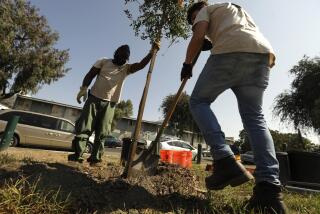GARDENING : Superficial Tree Care Is Root of Upheaval
- Share via
Too many of us homeowners have found ourselves mano a mano with a rampaging tree root. Quiet but irrepressible, roots can burst through curbs and driveways, invade pipes and challenge lawn mowers. They can lift garages high enough on one side that the doors won’t close.
Careful attention to where you plant a tree will help prevent future root problems, says Victor Eggers, a certified arborist with V&E; Tree Services in Orange.
Homeowners, wanting a finished look too quickly, tend to overplan landscaping at the outset. In the fevered quest for instant perfection, little thought is given to what all this infant plant life is going to do when it grows up.
Trees with shallow root structures cause the most damages to cement and masonry.
“Roots lift up the hardscape,” Eggers says. “Ficus keep me in business.”
Four of the most common trees types in Orange County--the ficus family, Shamel ash, liquid amber and the fruitless mulberry--are among those that send out feeder roots rather than a tap root. Feeder roots search out the easy water, which usually happens to be along the surface.
Although feeder roots may be insignificant before a tree matures, a 15- or 20-year-old ficus might have roots a foot thick. Some of that musculature will be trashing your walkways, sewage lines or swimming pool.
The best defense is a good offense. “If you have a tree that you think will cause problems in the future, the time to deal with it is now--when you first see that root,” says Jim Paramore, district manager for Davey Tree Surgery in Westchester.
Arborists use several approaches to deal with emerging tree roots, depending on their stage of development. In the tree’s early growth stages, many arborists encourage deep-root fertilization. They force a nutrient emulsion down below the root zone, providing a year or more of fertilization. A small tree might take 20 to 30 gallons of emulsion once a year.
Deep-root fertilization also provides a steady nutrient supply that counteracts drought conditions, says Bill Thomas, owner of the Brea Tree Co. and a certified arborist.
In addition to contributing water and fertilizer, deep root fertilization fractures and aerates the ground. The soil in much of Orange County is heavily compacted, Paramore notes. The ground can be so hard that roots penetrate only 12 inches.
Although deep-root fertilization will help control root development in the early stages, when the tree is mature the roots go where they want.
Because the tree will seek nutrients where they’re available, deep-root fertilization encourages the roots to head downward. “If you water the top two to six inches of soil, that’s where the roots will grow,” Thomas says.
The surface is the most hostile environment for the roots, Paramore says. Here the roots suffer the most from the sun’s heat and from lack of water.
Contributing to the problem, say certified arborists, is that many homeowners hire gardeners who aren’t tree people. “They’ll fertilize trees on top of the ground--but you want the roots to grow down, not up,” Paramore says.
Pruning the tree also helps to control the root system. Root zones extend out from one to one-and-a-half times the tree’s drip line, depending on the variety. Pruning the canopy from the outset will help contain the roots. “If you’ve got the right tree in the wrong place, prune it steadily,” Paramore says.
Despite the advice about periodic pruning, we’ve all been faced with dealing with a root that has crossed the line into arboreal anarchy.
“Generally they’re pushing up the sidewalk or the drive, or more than anything, the retaining wall. But it’s mainly because it’s planted too close to the wall,” Paramore says.
Homeowners usually want to deal with the roots before they remove the entire tree, Thomas says. “Just because the tree is giving them problems doesn’t mean the tree has to go.”
Although root pruning is a controversial approach, done properly it will eliminate part or all of the offending root while leaving the tree healthy. High-speed root-pruning tools minimize opportunities for fungus or bacteria buildup.
Cutting away part of a root will not kill the tree. There probably won’t be any damage to the tree if a root has been properly pruned and one has also compensated for the loss of root surface by pruning the tree branches, Thomas says.
Root pruning solves the root problem over the short term, but branching smaller roots will grow near the cut.
A root-control barrier can stop the spread of roots, but mechanical barriers are usually most effective when used with deep-root fertilization at the base of the barrier. Simply “putting a barrier around a tree is only buying you time,” says Tom Smith of TreeSmith Enterprises in Yorba Linda.
Chemical barriers are available, although at $3.50 a linear foot they are an expensive approach. Injected at the proper distance from the tree, the chemicals burn off developing root cells.
Arborists in Orange County commonly use a high-impact polystyrene barrier that costs $1.67 to $2.25 a linear foot, Smith says. The barrier is installed to a depth that ranges from 12 to 48 inches, depending on the variety of tree and the application. Root control barriers rarely have to go deeper than 24 inches, although protecting a pool might require a 48-inch deep barrier.
When all else fails in root control, something’s gotta go.
“I ask people, ‘What’s more important to you, the hardscape or the tree?’ ” Eggers says. About half his clients choose to save the hardscape, the other half the tree.
Regular attention to your trees will not only keep your property attractive, it can save you money resulting from hardscape damage caused by roots. And with lawsuits over injuries resulting from lifted hardscape becoming more common, attending to your roots is becoming increasingly important.






